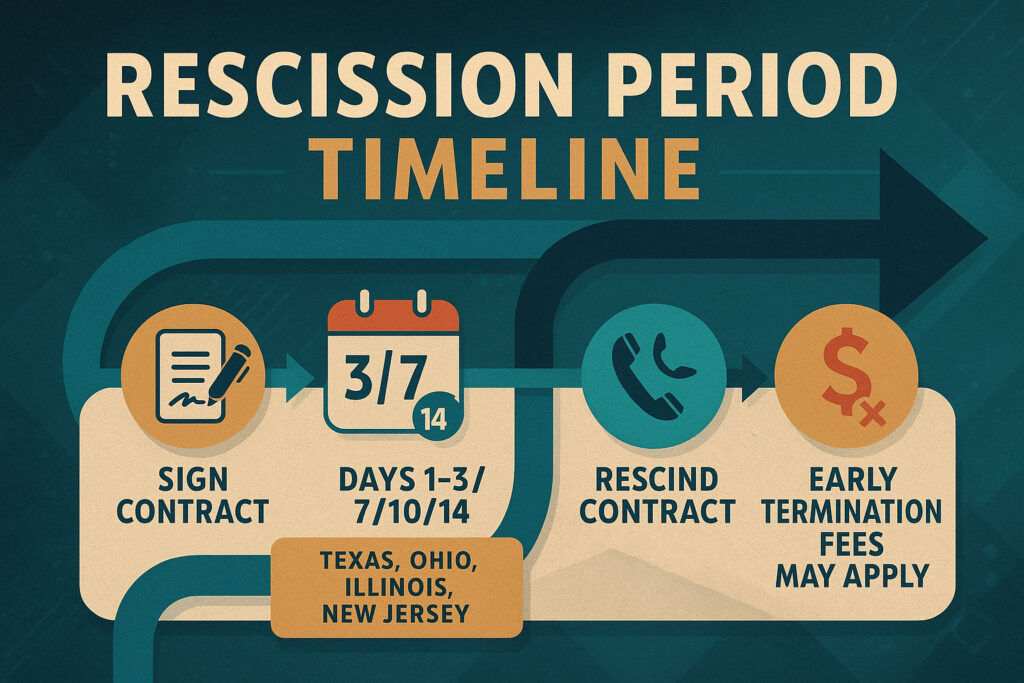Key Takeaways
- Most states give you a short period (usually 3–10 business days) to cancel a new energy contract without penalty.
- The rescission clock begins when you sign or receive the contract, not when your new service starts.
- Ohio offers 7 business days, Illinois 10 days, Texas and Georgia 3 days, while New Jersey allows 14 days.
- Once the rescission window closes, canceling early may mean paying termination fees, so review and decide quickly.
When you’re shopping for a new electricity or natural gas provider, you might feel a little nervous about signing a contract. After all, what if you change your mind or find a better deal the next day? That’s where rescission periods come in. Think of them as a safety net that gives you a chance to back out of a new plan, without penalties, if you decide it’s not the right fit.
What Is a Rescission Period?
A rescission period is a legally protected window of time that allows you to cancel a new energy contract without paying any fees. It’s designed to protect consumers from feeling locked in too quickly and gives you time to review the fine print. Essentially, it’s a “cooling-off period” that ensures you’re comfortable with your decision.
How Rescission Periods Work

Once you sign up for a new energy plan, your rescission period automatically begins. During this time:
- You can cancel your new plan with no penalty.
- You won’t be charged early termination fees.
- Your cancellation request is usually as simple as calling customer service or submitting an online request.
If you decide to cancel, the provider will either keep you with your current company (if you were switching) or simply void the contract.
When Your Rescission Period Starts in Regards to Contract Dates
Rescission periods typically start the day your contract is confirmed, not when your new service begins. That’s an important distinction because in many cases, your new provider won’t take over for a week or more due to utility scheduling.
For example:
- You sign a contract on Monday.
- Your rescission period (often 3–7 business days, depending on your state or utility rules) starts that same Monday.
- Your new service may not switch until the following week, but by then, your rescission period could already be over.
That’s why it’s smart to read through your contract immediately after enrolling, so you don’t miss the window to change your mind.
Other Helpful Information About Rescission Periods
A few extra things to know:
- State rules vary: Most deregulated markets (like Texas, Ohio, or Georgia) require a rescission period, but the length can differ.
- Written notice may be required: Some providers ask for a written cancellation request rather than a phone call. Always check the terms.
- No harm, no foul: Using the rescission period won’t hurt your credit, and you won’t be penalized by future providers for canceling.
- Automatic renewals are different: Rescission periods apply to new contracts, not auto-renewals. If your plan auto-renews, you’ll want to review that carefully.
State-by-State Snapshot
Rescission rules vary across states and providers. Here’s a handy overview for a few areas:
- Texas: You enjoy a 3‑business‑day rescission period under state law for residential electricity contracts. Cancel before midnight on the third business day to avoid fees.
- Maryland : A 3‑business‑day rescission applies before the contract becomes binding, cancel by phone or email.
- New York: Residential customers may cancel within 3 business days of signing or receiving the contract, no penalty for variable rate plans; fixed rate contracts may carry an early termination fee up to $100 or $200 depending on term length.
- Pennsylvania: State regs require a 3‑business‑day rescission starting upon receipt of disclosure.
- Ohio: If you enroll in a new natural gas or electricity plan, you’re allowed a seven-business-day window to cancel after receiving the confirmation notice from your current utility. You must contact that utility to rescind the enrollment, either verbally or in writing.
- Applicability: This rescission right applies only upon your initial switch to a new supplier. Renewals or auto-renewals typically don’t carry a new rescission window.
- Illinois: Rescission rights differ between electricity (Alternative Retail Electric Suppliers – ARES) and natural gas (Alternative Gas Suppliers – AGS).
- Electricity (ARES): You can cancel without penalty before the ARES submits the enrollment. Once the utility processes the enrollment request, it must send you written notice. From that notice date, you have 10 calendar days to rescind. If the 10th day falls on a weekend or holiday, the deadline moves to the next business day.
- Natural Gas (AGS): You have the right to rescind within 10 business days after the gas utility sends you its notice confirming the switch. For many providers, like Illinois Energy, you typically receive a written confirmation letter, and you may rescind within 10 business days of that letter.
- Georgia: Customers generally have a 3-day window to cancel after receiving the contract from the supplier.
- Termination fees: If you break your contract early (outside that rescission window), you might face a cancellation fee, commonly up to $100, depending on your plan.
- Note: While most sources confirm this 3-day rescission, always double-check the specific terms in the contract you sign.
- New Jersey: New Jersey has historically provided 14 calendar days for residential customers to rescind an energy contract, that’s from the date the Local Distribution Company (LDC) sends a confirmation of your supplier choice or the supplier sends your contract, whichever comes later. This generous window accommodates-mail delays and ensures you have enough time to review your decision.
Tips to Avoid Early Termination Fees
Nobody likes surprise fees, especially ones that can run into the hundreds of dollars. Here are some ways to avoid them:
- Act within your rescission period: If you’re second-guessing your choice, don’t wait, cancel while you’re still in the clear.
- Time your switch carefully: Before enrolling in a new plan, check when your current contract ends. Signing up too early could trigger early termination fees.
- Look for month-to-month options: If you’re unsure about committing, start with a no-contract or variable plan until you’re ready.
- Ask about waivers: Some providers will waive early termination fees if you move out of their service area or if you’re switching to a plan they also offer.
- Set reminders: Mark your contract end date on your calendar so you don’t accidentally roll into a renewal with penalties.
A rescission period gives you breathing room and peace of mind when committing to an energy plan. Use it wisely, review your contract right away, and don’t be afraid to cancel if something doesn’t feel right.
FAQs About Rescission Periods
What is a rescission period?
How long is the rescission period?
When does the rescission period start?
How do I cancel during the rescission period?
Will canceling hurt my credit or cost me money?
What happens if I miss the rescission deadline?
About the Author
David has been an integral part of some of the biggest utility sites on the internet, including InMyArea.com, HighSpeedInternet.com, BroadbandNow.com, and U.S. News. He brings over 15 years of experience writing about, compiling and analyzing utility data.
